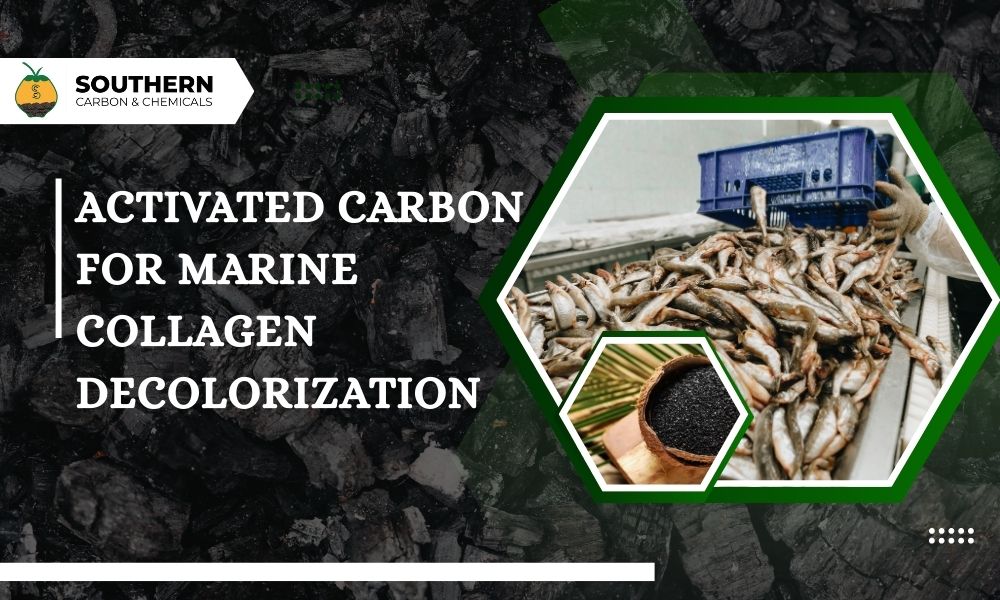
From a health perspective, fish scales, flesh, bones, and skin are in high demand due to their significant nutritional value. Marine collagen, in particular, is very popular nowadays. As the market thrives, producers must ensure their methods meet strict purification and aesthetic requirements. But before delving further, let’s take a deeper look at the concept of marine collagen.
What is Marine Collagen?
Fish meat or fish eggs are the main source of Marine collagen. It is necessary for everyone to include one item of marine collagen in their diet to balance their diet. The benefits of collagen high nutritional value, easy absorption, and low fat. The process of removing and purifying fish proteins is known as “fish protein decolorization.
Why decolorization in marine collagen?
One of the crucial steps in marine collagen extraction is decolorization, a process that removes unwanted elements such as pigments, odours, and impurities that could affect product quality. Activated carbon is an effective solution for this process, efficiently adsorbing contaminants while preserving collagen’s beneficial properties.
The blog explores how activated carbon is manufactured by the leading activated carbon manufacturers in Korea, India, the USA, and Japan.
How is activated carbon significant in marine collagen?
Activated carbon is essential in marine collagen because it is a structural protein extracted from the skin, scales, bones, and flesh of the fish. The tissue of the fish and other marine organisms, such as jellyfish, sponges, and shell fish. There are other collagen-like bovine or porcine collagens, but among the varied varieties, the marine collagen is highly bioavailable, meaning the body absorbs it more efficiently, making it a preferred choice in health, beauty, and medical industries.
Why is Marine collagen popular?
Supplements: Marine collagen is widely used in supplements, such as powders, capsules, and drinks, to support skin elasticity, joint health, and muscle recovery. Nowadays, people often take health supplements based on their body’s nutritional needs, as daily diets may not always provide the necessary nutrients.
Cosmetics: In cosmetics, marine collagen plays a significant role. It is commonly added to creams and serums for its anti-aging and hydrating effects, thanks to its ability to stimulate collagen production in the skin.
Medicinal Applications: One of the key properties of marine collagen is its ability to aid in wound healing, tissue regeneration, and bone repair. Due to these benefits, it has become highly valuable in various medical applications.
What Impurities Are Found in Raw Marine Collagen?
Freshly extracted marine collagen often has a dark or yellowish tint and may carry unpleasant fishy odours.
There are unwanted residual components such as melanin and hemoglobin.
The impurities also include lipids and fatty acids.
The marine collagen undergoes an oxidation process, causing discoloration.
Ultimately, marine collagen products must undergo essential processing steps such as decolorization and purification. Activated carbon plays a vital role in this process by effectively removing unwanted impurities while maintaining the product’s beneficial properties, making it suitable for further applications.
How is marine collagen decolorized?
The extracted collagen will have many elements, including chemical bleaching, enzymatic treatments, membrane filtration, and absorption.
Among the above-mentioned procedures, activated carbon adsorption stands out as the most economical, environmentally friendly, efficient, natural, and cost-effective solution.
Activated carbon from Southern Carbon safely captures pigments, odours, and impurities while maintaining the positive qualities of collagen, unlike harsh chemical treatments that could degrade its properties and quality. It efficiently absorbs unwanted odours and pigments.
The speciality of activated carbon lies in its reusability and eco-friendliness, making it an ideal choice for producers seeking a safe, clean, and high-quality material, especially since marine collagen is used in food, cosmetics, and medical applications.
Benefits of using Activated Carbon for effective Decolorization
- Activated carbon has a high adsorption capacity to remove a wide range of impurities from the sugar solutions.
- The regenerative property of carbon makes it usable multiple times, which improves cost-effectiveness and reusability.
There are different techniques to remove the impurities and decolourization, which are environmentally friendly compared to some chemical treatments.
What are the types of activated carbon used?
Southern Carbon has different types of activated carbon for marine collagen:
Powdered Activated Carbon:
It is activated carbon in powder form, consisting of fine particles that enable fast, efficient decolorization in liquid collagen. It is also ideal for batch processing for nutraceutical and cosmetic applications.
Granular Activated Carbon:
As the name suggests, it consists of larger granules used in continuous-flow filtration systems. It is best suited for large-scale industrial production.
Conclusion
Activated carbon is an effective and powerful solution for marine collagen decolorization. It removes harmful pollutants, toxins, odour, colour, and unwanted elements. It makes the final product for further standardization and fit for human consumption. With high efficiency, eco-friendliness, and cost-benefits. Regular monitoring and proper use are necessary to maintain efficacy in the functioning of the decolourization process.
The booming demand for activated carbon is driving industrial growth, particularly the coconut shell activated carbon price in India is comparatively affordable for industrial purposes and treatment. The rapid rise in its attributed to the numerous advantages of activated carbon, making it a key component in environmental sustainability and industrial advancements. Southern Carbon is rising and leading the activated carbon manufacturers. Please visit our website or contact us for more details.
